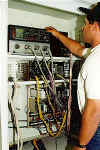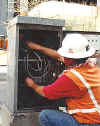WHAT
WE DO
July/August 1998 IBEW Journal
Ed. Note--In the June 1998 issue of the IBEW Journal,
our Letters to the Editor column featured a letter
from a member of Local 111, Denver, Colorado, asking why we had
never featured the work of the Traffic Signal Division in the Journal.
So, we obtained information about this facet of electrical work
and are pleased to present the following story.
Getting Our Work Back
 The
traffic signal construction market in the Denver metropolitan area
has had a variety of contractors over the past several decades.
Until recently, nonunion contractors, with little or no training,
were doing traffic signal construction work. This went on for several
years. And the two local unions in Denver--Inside electrical construction
Local 68 and outside electrical construction Local 111--could not
agree on which local should control the work. Each felt that traffic
signal work was part of their jurisdiction. In addition to the jurisdictional
issues, neither union contract could provide workmen at a rate that
would have been competitive in the industry. The
traffic signal construction market in the Denver metropolitan area
has had a variety of contractors over the past several decades.
Until recently, nonunion contractors, with little or no training,
were doing traffic signal construction work. This went on for several
years. And the two local unions in Denver--Inside electrical construction
Local 68 and outside electrical construction Local 111--could not
agree on which local should control the work. Each felt that traffic
signal work was part of their jurisdiction. In addition to the jurisdictional
issues, neither union contract could provide workmen at a rate that
would have been competitive in the industry.
In lean times, there wasn’t enough work going on to worry
about, so both locals ignored the fact that nonunion contractors
were doing more of the work than IBEW contractors.
Concurrently, many local municipalities were enforcing tougher
bid qualifications seeking to correct the poor quality of work they
were getting on their signal installations. Sometime during the
late 1980s and early 1990s, both Local 111 and Local 68, Collier
Electric and Sturgeon Electric decided to correct the situation.
With a Memo of Understanding covering the jurisdiction, put together
by Eighth District International Vice President Jon Walters, a pact
was form among the parties to reorganize the Traffic Signal Industry
in Colorado. A standardized agreement was negotiated between the
parties and with the cooperation of the Mountain States Apprenticeship
Director, S.K. Pelch, a corresponding Traffic Signal Apprenticeship
Program was developed. Several knowledgeable and experienced craftsmen,
from both the nonunion and unionized labor pool were solicited to
begin the task of training a work force dedicated to compete strictly
with the Traffic Signal Industry. Then Assistant Business Manager
Mike Ward and Sturgeon Electric Service Department Manager Steve
Kimsey cooperated to recruit bargaining unit members--Scott Delaroy
and Jim Bushnell, who became instructors for the apprenticeship
program. The program took off rapidly, with the donation of traffic
control equipment and input for developing lessons and tests.
 After
five years, Mike Ward resigned as Construction Agent for Local 111
and shortly thereafter, Dana Crownover was hired as Construction
Agent under Business Manager Mason. The Colorado Statewide Traffic
Signal and Low Voltage Agreement was negotiated with pay scales
and conditions that were competitive in the traffic signal construction
market. The agreement also created a classification of workers specific
to traffic signal and street light work. Since that time, 10 Journeyman
Traffic Technicians have graduated through the program and there
are presently nine people in various steps of apprenticeship. After
five years, Mike Ward resigned as Construction Agent for Local 111
and shortly thereafter, Dana Crownover was hired as Construction
Agent under Business Manager Mason. The Colorado Statewide Traffic
Signal and Low Voltage Agreement was negotiated with pay scales
and conditions that were competitive in the traffic signal construction
market. The agreement also created a classification of workers specific
to traffic signal and street light work. Since that time, 10 Journeyman
Traffic Technicians have graduated through the program and there
are presently nine people in various steps of apprenticeship.
 In
early 1992, IBEW contractors were already performing a
small amount of the work in the area. Initially Collier Electric
and Sturgeon Electric were bidding the work under the terms and
conditions of the Colorado Statewide Line Construction Agreement,
with a Letter of Understanding, that allowed workmen, classified
as "groundmen," to act as foremen on traffic crews. Members
of outside Local 111 and inside Local 68 were jointly established
and worked together. They did basic construction work, building
traffic systems from the ground up, including trenching, laying
conduit, wiring traffic signal boxes, signal repair and are now
performing work on various municipal and state traffic control systems
across Colorado. The volume of work now in Colorado has ballooned
to such a level that IBEW contractors, Sturgeon Electric
and Kimsel Electric are now experiencing a severe shortage of qualified
manpower. In
early 1992, IBEW contractors were already performing a
small amount of the work in the area. Initially Collier Electric
and Sturgeon Electric were bidding the work under the terms and
conditions of the Colorado Statewide Line Construction Agreement,
with a Letter of Understanding, that allowed workmen, classified
as "groundmen," to act as foremen on traffic crews. Members
of outside Local 111 and inside Local 68 were jointly established
and worked together. They did basic construction work, building
traffic systems from the ground up, including trenching, laying
conduit, wiring traffic signal boxes, signal repair and are now
performing work on various municipal and state traffic control systems
across Colorado. The volume of work now in Colorado has ballooned
to such a level that IBEW contractors, Sturgeon Electric
and Kimsel Electric are now experiencing a severe shortage of qualified
manpower.
Locals 111 and 68 members are proud of their accomplishments and
even prouder of the fact that they combined their efforts to get
the work and now have more than they can handle.

|
|
